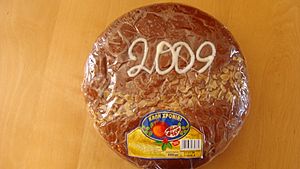Vasilopita facts for kids
 |
|
| Type | Bread or cake |
|---|---|
| Place of origin | Greece or Cyprus |
Vasilopita (which means '(St.) Basil-pie' or 'Vassilis pie' in Greek) is a special bread or cake. People in Greece and other parts of eastern Europe and the Balkans eat it on New Year's Day. It has a secret coin or small charm hidden inside. Finding this coin is thought to bring good luck for the new year!
Vasilopita is a lot like the King cake eaten in Western Europe. It's often linked to Saint Basil's Day, which is on January 1st. In some places, though, the tradition of a cake with a hidden coin happens at Epiphany or Christmas.
Contents
What is Vasilopita?
Vasilopita can be made from different kinds of dough. This depends on what families and regions traditionally do. Sometimes, it's made from a sweet bread dough called tsoureki. Other times, it's made from a creamy custard base. This custard version is called galatopita, which means "milk-pie."
A Special New Year's Tradition
This lucky cake is also known as Chronópita. This name means "New Year's pie." It's a sweet way to celebrate the start of a brand new year. The tradition of a cake with a hidden coin is found in other countries too. For example, people in Ukraine, Romania, Serbia, Albania, and Bulgaria have similar customs.
Different Kinds of Vasilopita
In Bulgaria, a special round bread called pita or pitka is made for important days. On the night before Christmas Eve, families make a pita. They decorate it with symbols to wish for good harvests and healthy animals. A coin is hidden inside, and whoever finds it is believed to be the healthiest and wealthiest.
When a bride is about to get married, her future mother-in-law makes a pita for the new couple. She sifts the flour many times. This is to make the bread soft, hoping their life together will be smooth and happy. Pita is also used to welcome guests. A traditional Bulgarian welcome includes pita with honey or salt. This shows how important bread is in their culture.
How is Vasilopita Celebrated?
On New Year's Day, families cut the vasilopita. This is done to bless their home and bring good luck for the year ahead. Usually, this happens right at midnight on New Year's Eve. Before baking, a coin is carefully slipped into the dough and hidden.
The Lucky Coin Ritual
At midnight, someone uses a knife to draw the sign of the cross on the cake. Then, slices are cut for everyone present. The slices are given out from the oldest person to the youngest. Extra slices are also cut for special symbolic people or groups. These might include the Lord, Saint Basil, other saints, or even the house itself. Sometimes, a slice is even cut for the Kallikantzaroi, who are mischievous goblins in Greek folklore!
In the past, the hidden coin was often very valuable, like a gold coin. Today, families usually have a gift ready for the person who finds the coin. This gift can be money or something else special. Many groups, like clubs or workplaces, also cut their vasilopita. They do this sometime between New Year's Day and the start of Great Lent. These gatherings can be simple get-togethers or big parties.
The Story Behind Vasilopita
The tradition of vasilopita is linked to a famous story about Basil of Caesarea. One legend says that Saint Basil asked the people of Caesarea to gather gold and jewelry. This was to pay a ransom and stop an army from attacking their city. Everyone gave what they had.
When the ransom was collected, the enemy was so impressed by their generosity that they left without taking the payment. Saint Basil then had to return all the gold and jewelry. But he didn't know which items belonged to which family. So, he baked all the treasures into loaves of bread. He gave these loaves to the city, and by a miracle, each person received their exact share back! In some versions of the story, Saint Basil was simply trying to give charity to the poor without making them feel embarrassed.
Origins of the Tradition
Historians believe that the tradition of vasilopita might be connected to very old celebrations. These include the ancient Greek festival called Kronia, which honored Cronus. During Kronia, a "king" was chosen by chance. The Roman festival of Saturnalia also had similar customs.
The traditions around vasilopita are very much like other European celebrations. For example, the Twelfth Night and Epiphany (holiday) holidays have similar customs. The king cake in France and Louisiana, and the tortell in Catalonia, are all examples of cakes with hidden surprises.
Images for kids


